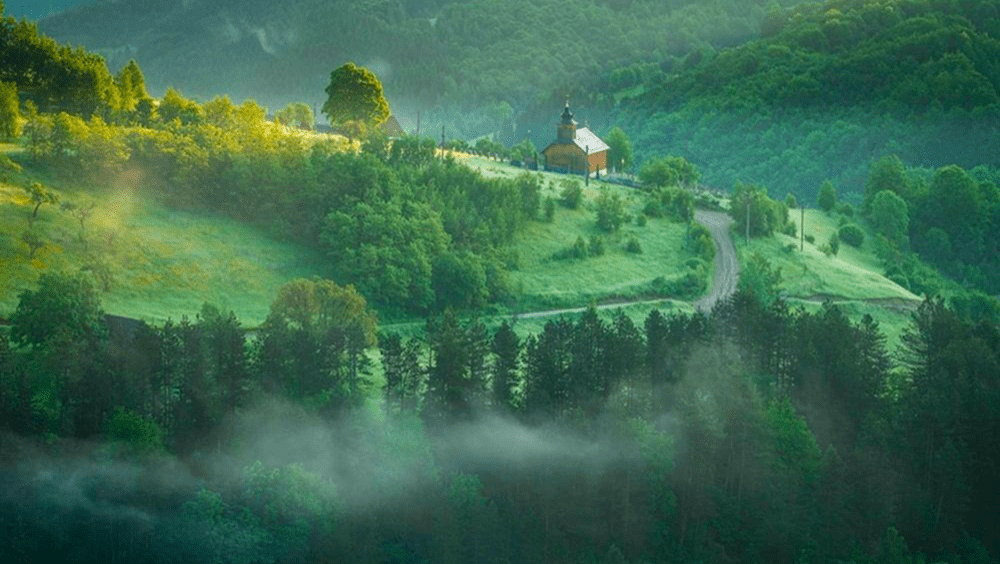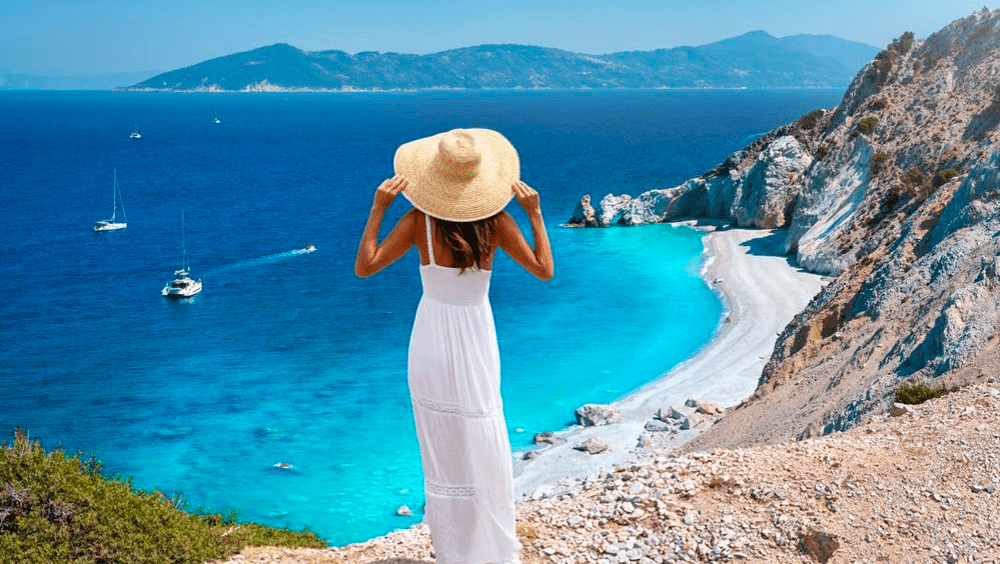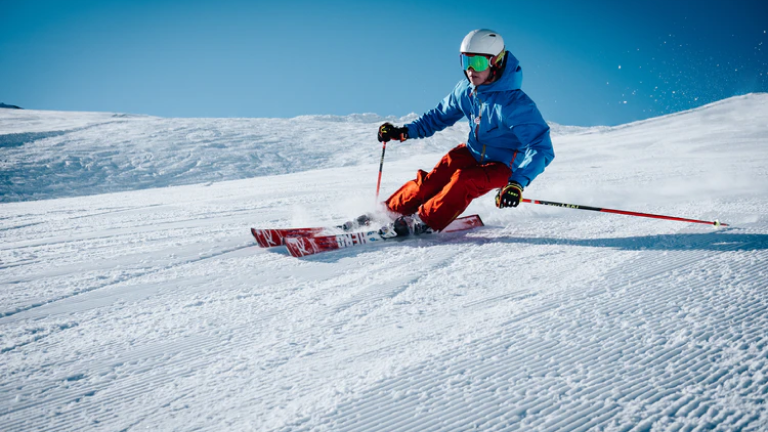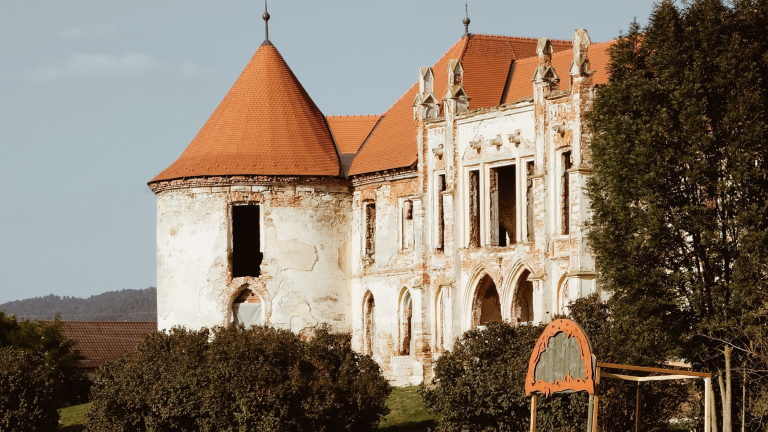Istanbul’s Grand Bazaar: curiosities and tips
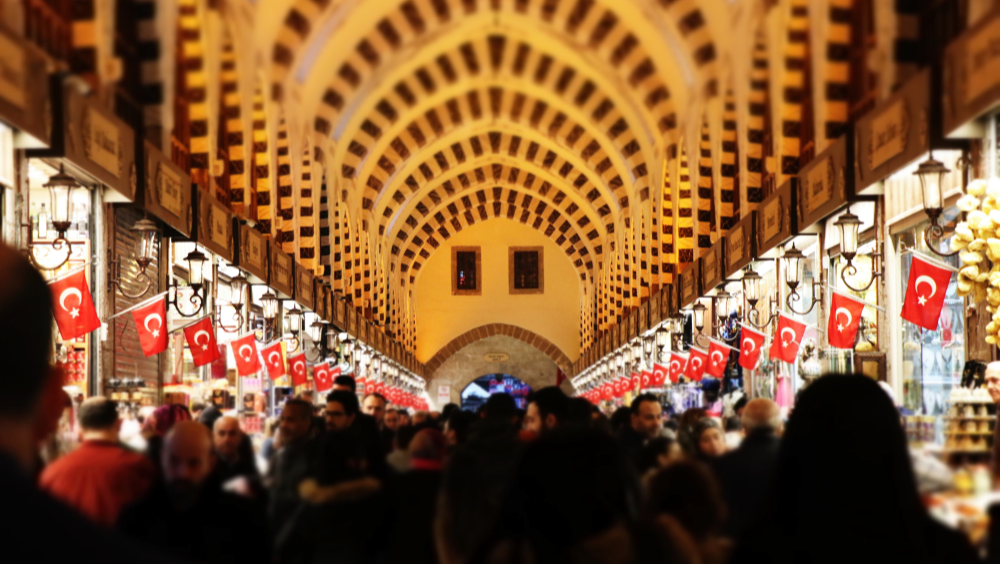
No trip to Istanbul is complete without at least one visit to the Grand Bazaar. Under its domes, the world’s only city on two continents reveals its soul. Its narrow streets, steeped in history, lead you through a maze of shops, where flavors and colors weave in a hypnotic dance.
Hand-woven carpets, with their vibrant hues, are like windows into the past. They preserve the echoes of travels and negotiations from bygone times. Here, a rug is not just a decorative fabric or for the comfort of a room; it’s a story laid under your feet, a journey through time and space. The jewelry, glittering in the showcases, reminds you of times long gone, and each precious stone has a story to tell.
Istanbul is not far from our country, and the 400 miles to Istanbul can be covered by car in just nine hours. So here’s our guide to Istanbul’s Grand Bazaar, along with the information you need for a successful shopping trip.
- A brief history of the Istanbul Grand Bazaar
- Istanbul Grand Bazaar – curiosities
- How to get to the Grand Bazaar by car
- What to buy in Istanbul Grand Bazaar
- How and how much to negotiate prices
- Customs policy for goods bought in Turkey
A brief history of Istanbul’s Grand Bazaar
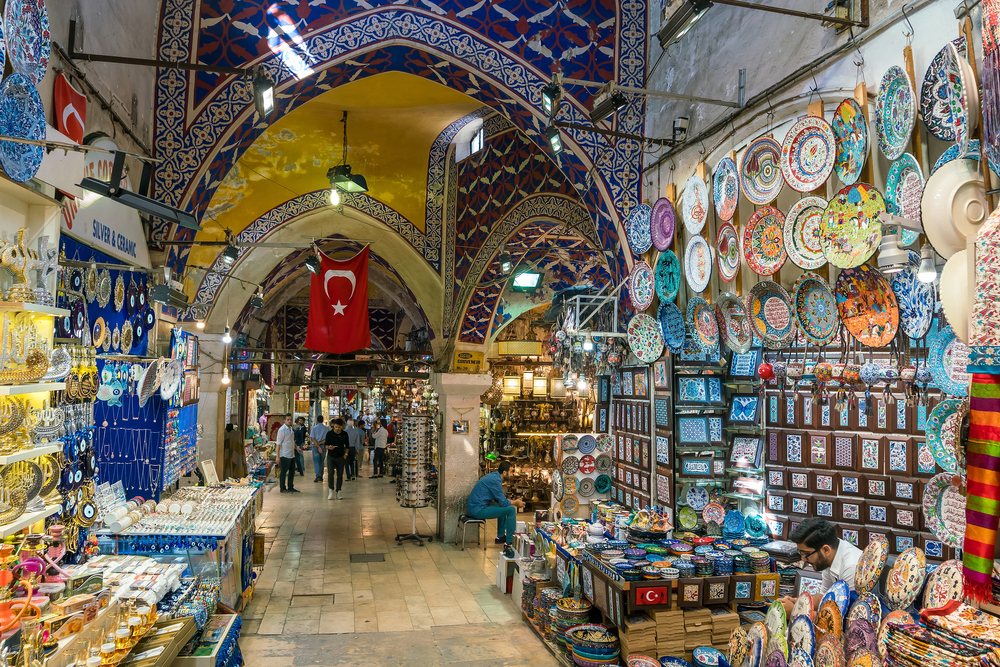
Kapalıçarșı (‘covered market’) or Büyüük Çarșı (‘big market’), as Istanbul’s Grand Bazaar is known in Turkish, was created by order of Sultan Mehmet II in the winter of 1455, shortly after the Ottomans conquered Istanbul.
In the beginning, the market sold only textiles and was therefore called Cevahir Bedesten or Bedesten of Gems, the word “bedesten” in Persian meaning “bazaar of cloth sellers”. Structurally, the market was built of brick and wood, with large, vaulted arches, and the walls were, as today, ornamented with painted plasterwork.
A few years later, Sultan Mehmet II ordered the construction of another covered market, called Sandal Bedesten, named after a kind of textile thread woven in Bursa, which is the color of sandalwood. After a while, all textile goods were moved to Sandal Bedesten, and Cevahir Bedesten was reserved for the luxury goods trade.
The physical and geographical position of the Ottoman Empire made the Bazaar an extremely important point in Mediterranean trade. According to a number of European travelers, from the Middle Ages until the first half of the 19th century, the market was unparalleled in Europe in terms of abundance, variety and quality of products.
Today, the Grand Bazaar remains a must-see destination for any visitor to Istanbul. Its evolution over the centuries reflects not only the city’s history but also changes in global trade and consumer tastes.
Istanbul Grand Bazaar – curiosities
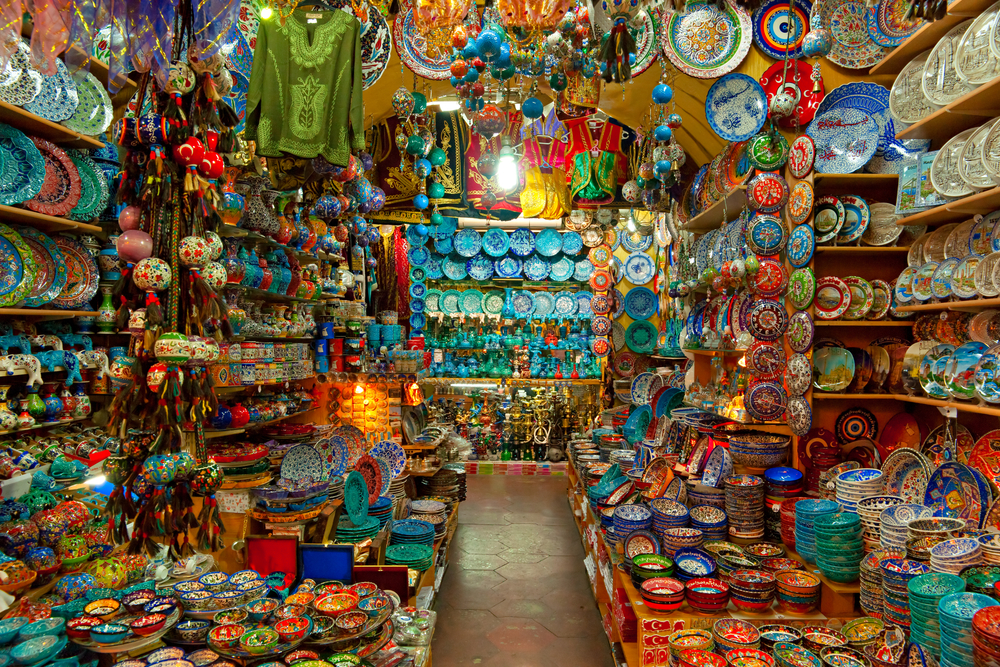
Considered to be one of the world’s first shopping malls, the Istanbul Grand Bazaar covers an impressive 30,700 square meters, with 61 covered streets and more than 4,000 shops, attracting between 250,000 and 400,000 visitors daily.
The huge market is located within the Old Town, in the Fatih neighborhood, and is positioned roughly between the Beyazıt and Nuruosmaniye mosques. It has 21 entry points, but the most important are the five main gates:
- Beyazıt Kapısı (entrance from Beyazıt Square);
- Çarșıkapı (next to Beyazıt tram station);
- Nuruosmaniye Kapısı (next to Çemberlitaș tram station);
- Örücüler Kapısı (near the tram stop coming from Eminönu neighborhood);
- Mahmut Pasa Kapısı Kapısı (next to the tram stop coming from the Sirkeci neighborhood).
This shopping complex is designed to function as a “city within a city”, offering all the necessary facilities to ensure a pleasant experience for visitors. The presence of its own police station contributes significantly to maintaining order and safety within the space and provides a feeling of increased security. The on-site medical center also ensures quick access to medical assistance in case of emergency and demonstrates a commitment to the well-being of guests.
These elements underline the complexity and autonomy of this space, making it a favorite destination for shopping and relaxation.
The Grand Bazaar has stood the test of time, despite the many disasters that could have destroyed it. For example, in 1894, a devastating earthquake damaged the bazaar’s structure, but reconstruction began quickly and was completed in record time, restoring over 4,000 shops. In 1954, a major fire destroyed a significant part of the bazaar, but with the help of the local community, repairs were completed in less than a year.
The culture of bargaining is still alive here and gives you the chance to practice your haggling skills and enjoy an authentic shopping experience. In many traditional markets and bazaars, bargaining is not only accepted but expected and an integral part of commercial interactions. This practice not only allows you to get the products you want at better prices, but also gives you the opportunity to interact directly with the vendors, better understand the local culture and form personal connections.
The Grand Bazaar is open from 09:00-19:00, Monday to Saturday, with some small shops starting even earlier at 8:30. Closed on Sundays. The best time to shop is before lunchtime, with the afternoon market extremely busy.
How to get to the Grand Bazaar by car

If you’ve decided to go to Istanbul for a big shopping spree in the Istanbul Grand Bazaar, it’s advisable to do so by car, not only for the advantages it offers in terms of luggage space, but also because of the possibility to stop off on the way whenever you need to.
In addition to the road and bridge toll that you have to pay on Bulgarian territory, you need to buy an HGS sticker stamp when you enter the country. This is obtained by paying 35 Turkish lira (TL) at any post office (PTT) and, after being placed on the windshield, can be read by the marked toll gates.
To navigate Istanbul’s streets, you can use a GPS system, and once you’re in the Old City, you can follow the signposts to the Grand Bazaar. Parking in Istanbul’s central area can be difficult, but you can find free parking in private or public parking lots (Palas Otopark, Emin Sinan Otopark, etc.) and in the streets surrounding the covered market.
👉 If you want to travel to Istanbul by car so that you have enough space to shop in the Grand Bazaar, use the flexible services of Enterprise Rent-a-Car Romania and rent one of the wagon class cars with generous luggage storage space.
What to buy in Istanbul’s Grand Bazaar

Although the comprehensive market seems to have something for everyone, only certain shops are worth visiting and only certain products are worth buying. As inspiration for your future purchases in the Istanbul Grand Bazaar, we’ve put together some tips on the most sought-after and quality-worthy goods.
Jewelry in gold, silver, precious and semi-precious stones
In Istanbul’s Grand Bazaar, jewelry is more than just objects – it’s a treasure trove of history, culture and beauty. Here, under the market domes, you’ll find a wide range of products, from ornaments inspired by Ottoman, Persian and Arabic art to contemporary creations.
The Grand Bazaar is also a gemstone paradise, whether we’re talking precious rubies, sapphires, diamonds and emeralds or garnets, tourmalines, topaz and amethysts.
Merchants will present you with a variety of options, from classic to modern jewelry. Alongside these, filigree jewelry is an old tradition in Istanbul. This delicate technique involves interweaving thin strands of metal to create different patterns, to which enamels, with their vibrant colors, add a touch of elegance.
Carpets and rugs
The Grand Bazaar is the meeting point for chillim made all over Turkey, as well as for carpet makers who have the rarest handicrafts in their collections. Here you can find Hereke carpets, known as the world’s finest weavings and considered the synthesis of traditional Anatolian weaving.
The value of the handmade carpets sold in the Istanbul Grand Bazaar is determined by the amount of handwork, the age and the colors used. Whether you choose a silk rug to decorate your living room or a decorative cushion with oriental motifs, these pieces will add a touch of exoticism and sophistication to your home.
Copper objects
Among jewelry and textiles, you’ll also discover a fascinating range of brass products. Whether it’s lamps and chandeliers in filigree patterns, cutlery and crockery with geometric or floral motifs, mirrors, frames, vases or stands, we’re sure you’ll find something to suit your taste, to beautify your home and remind you of the world of the Orient.
Bakırcılar Çarșșısı, the copper workers’ market next to Istanbul’s Grand Bazaar, offers thousands of handmade copper objects using techniques hundreds of years old. Each piece reflects the craftsmanship of artisans carrying on a tradition handed down from generation to generation.
What’s more, you can watch the craftsmen at work, hammering decorative patterns with precision directly onto the metal surface. The authentic atmosphere and the distinctive sound of hammers striking the copper make this market a memorable experience, more than just buying a souvenir.
Silverware
Turkey has a long tradition of silver working, which began to develop particularly in the 16th century with the production of household goods. To ensure that the handicrafts sold in Istanbul’s Grand Bazaar are authentically crafted and that the knowledge is passed on to future generations, the Turkish state has set up associations to identify and pay special attention to silver craftsmen.
You can buy from the covered market various decorative objects, jewelry adorned with semi-precious stones, candlesticks, amulets, medallions with Islamic and Ottoman symbols, each of them with a story and a meaning.
Leather products
During the Ottoman period, Turkish leather products, which developed most during this period, began to be sought abroad. At that time, processed Turkish leather became a favorite on European markets and this situation lasted until the early 19th century.
In the Grand Bazaar, leather products stand out for their quality workmanship and superior raw materials. You can choose from an almost endless range of belts and accessories, shoes and boots, jackets and jackets, bags, purses and wallets, all crafted with meticulous care and taste.
Whether you’re looking for a special gift or want to complete your wardrobe with quality pieces, Turkey’s Grand Bazaar has everything you need. You’ll find designer clothes, made from fine leather, at much more affordable prices than in regular stores.
In the Grand Bazaar, tradition meets contemporary fashion, giving you the chance to wear exclusive items with a story behind them. It’s a place where every purchase becomes an experience in itself.
Other bazaar treasures
The bazaar’s other treasures are not just objects, but capture the essence of Turkish culture through color, aroma and tradition.
Hand-painted ceramics and porcelain, with motifs inspired by Ottoman art, are not only decorative pieces, but also bring an oriental touch to your table. Intense spices and aromatic teas turn your kitchen into a corner of Turkey, and a spoonful is enough to change the taste of a recipe.
Turkish sweets, delicate nutty rah and crispy baclava, are perfect for moments of indulgence or to give as gifts. Plus, you can choose personalized souvenirs, postcards and items printed with photos of Istanbul’s Grand Bazaar or Turkish landscapes to keep a visual memento of the experience. With so many options at every turn, take your time to explore, bargain and enjoy the vibrant bazaar atmosphere.
👉 For hassle-free travel and maximum mobility in Istanbul, rent a car directly from the airport with Enterprise Rent-a-Car International. Discover all available locations here: Enterprise – International Locations.
How and how much you negotiate prices
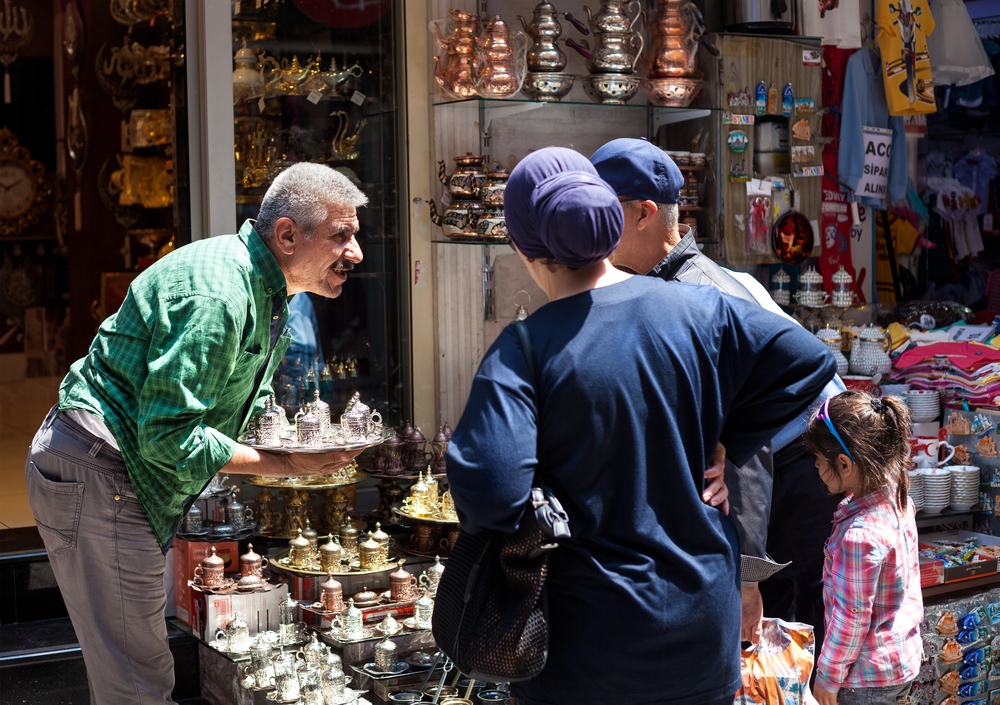
The art of negotiating the price of a product may seem old-fashioned, with some Grand Bazaar shops preferring the Western fashion of fixed prices written on labels. However, many traders still use bargaining successfully today, and visitors should be familiar with how it works and keep a few things in mind:
- The initial price is almost always artificially increased by 20-30% to allow for a margin of negotiation.
- The buying process follows the rule of Ottoman etiquette – you’ll be served tea, exchange polite phrases and try to see how trustworthy the merchant is, who in turn will gauge your gullibility.
- Because Turkey is a very family-oriented society, don’t look surprised if the shop assistant asks about your marital status or children as a conversation starter.
- Tea and polite conversation are free – accepting it doesn’t mean you have to buy anything in return.
- It’s important to visit other shops before you buy anything, to familiarize yourself with the prices and quality of goods.
- Decide in advance how much you like the item you want to buy and how much you’re willing to pay for it – shopkeepers here are professional negotiators and are practiced at persuading customers to buy even what they don’t really want.
- The first offer you make should be around 50-60% of the original asking price, at which point the merchant will either laugh, look offended or confess to being puzzled – all part of the ritual.
- The trader will then make a counteroffer of 80-90% – now you should look disappointed, explain that you know what the real prices are for the product, communicate that you are not prepared to pay that amount, then offer around 70%.
- At this point, the trader will tell you the price at which he is prepared to sell and, if it matches your estimates and calculations, you close the deal. If not, you should smile, shake his hand and walk away. You may find that the trader will lower the price even further.
Customs policy for goods bought in Turkey
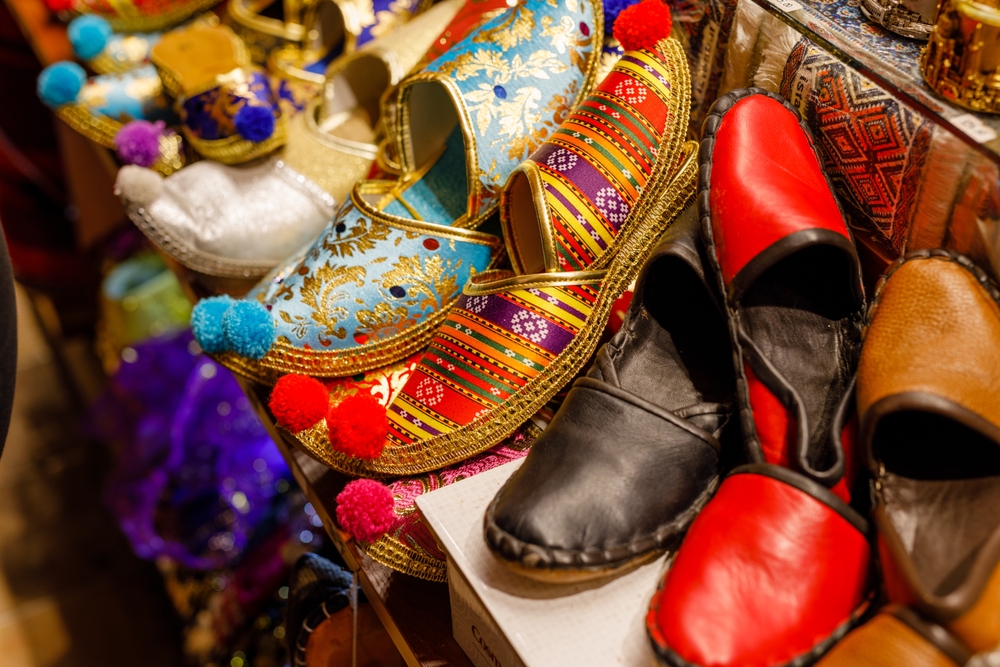
According to the MFA website, jewelry made of precious metals and precious stones worth $15,000 or more that have not been bought for trade can be taken out of Turkey if it can be proved that they were bought legally.
Turkish law is not very explicit about the term ‘antiquities’. Therefore, if you intend to buy an art object, it is advisable to ask for an invoice and a certificate confirming that it can be legally exported.
Romanian citizens who buy goods in Turkey can recover VAT on almost any product worth at least €30.
👉 Find out more about the advantages of traveling abroad by car in our article Travel abroad with a rental car.
Istanbul’s Grand Bazaar is not just a market but a window into the soul of the fascinating metropolis that is Istanbul. Here, minarets soar skywards and the Bosphorus opens its arms to the sea. In every street of the market, in every glance of the vendor, you feel the pulse of this magical city that continues to captivate and surprise.
Photo source: Shutterstock.com

